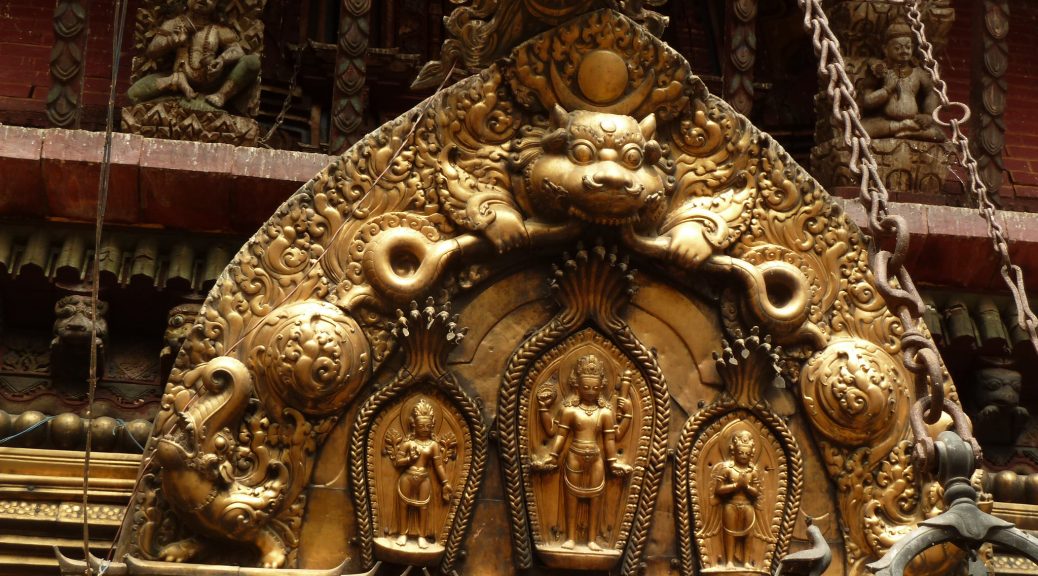The Changu Narayan temple is a religious heritage site located in the Kathmandu Valley, historically known as the Nepa, or Nepal valley, in the province of Bhaktapur, Nepal. The country of Nepal has a very strong Hindu presence with roughly 80% of the population identifying as Hindu (Burke, 1). The temple is located on the top of a hill 12 kilometers east of Kathmandu, the capital and largest city in Nepal, and is surrounded by chimpak trees. The Changu Narayan temple is considered by most to be the oldest temple in Nepal’s history. The exact time when the temple was created is unknown, but it is said to have been created during the time of the Licchavi kingdom (400 – 750CE) (Sharma, 3). The temple pays homage to the deity Visnu and is considered the most important temple in the valley (Sharma, 1999, 8).
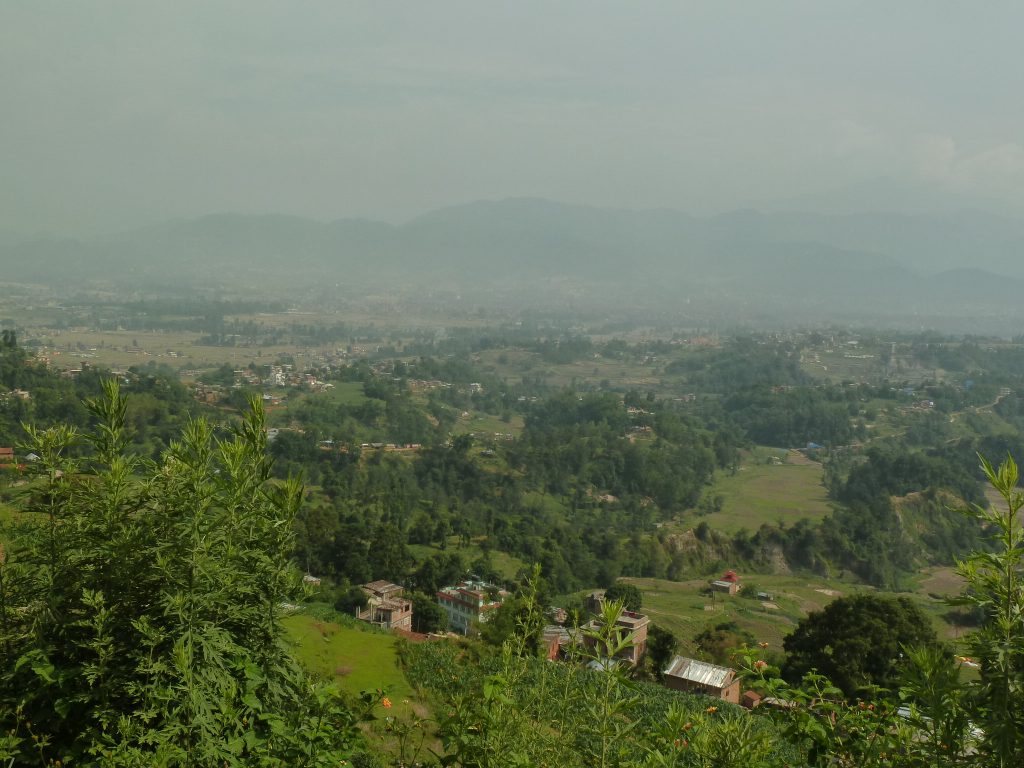
This temple is one of four major temples in Nepal’s surrounding area dedicated to the Hindu deity Visnu. Changu Narayan is the earliest and most famous temple dedicated to Visnu, but many other temples dedicated to various other deities can be found throughout Nepal. Visnu first appears in the Rg Veda as a solar deity with a part of him representing the sun (Krishna, 7). Visnu has a wide variety of depictions across the various Hindu denominations. In early vedic religion Visnu was a minor god, but as the religion progressed he grew in strength and popularity until he was recognized as one of the most powerful gods in Hinduism (Krishna, 9).
The temple’s origin story stems from an ancient legend concerning the deity Visnu. Harsimran Kaur’s article summarizes the legend of the creation of the Changu Narayan temple and its relevance to Visnu. A gwala, or cow herder, had purchased a cow from a brahmin that was renowned for producing large quantities of milk. The gwala often took this cow to a forest of Champak trees to graze on the grass, however the cow would always go into the shade of its favourite tree where a boy would drink the cow’s milk. In the evenings, the gwala would return home to milk the cow but found that he would only get a small amount of milk from the cow. This trend continued for several days and the gwala became very sad. The gwala went back to the brahmin that sold him the cow and explained how the cow was no longer producing the large quantities of milk. The next day the brahmin and the gwala hid and observed the cow’s behaviour through the day. They noticed the little black boy drinking the cow’s milk and the two men thought that the boy must be a devil that lived in the cow’s favourite tree. The two men became furious and began to cut down the tree, but when they struck the tree they noticed human blood coming from it. The two got worried and feared that they had committed a serious crime. The Lord Visnu then emerged to the two men and explained that those events were not their fault. Visnu then told them his story of how he unintentionally killed Sudarshan’s father while hunting in the woods. Afterwards, he was cursed for his sins and wandered the earth until ending up on the Changu hill where he survived using the stolen cow’s milk. When the brahmin and the gwala cut down the tree, Visnu was decapitated and freed from his sins. After listening to Visnu’s words the two men decided to erect a temple in honour of Visnu. The temple has been considered sacred since the site was constructed (Kaur, 1).
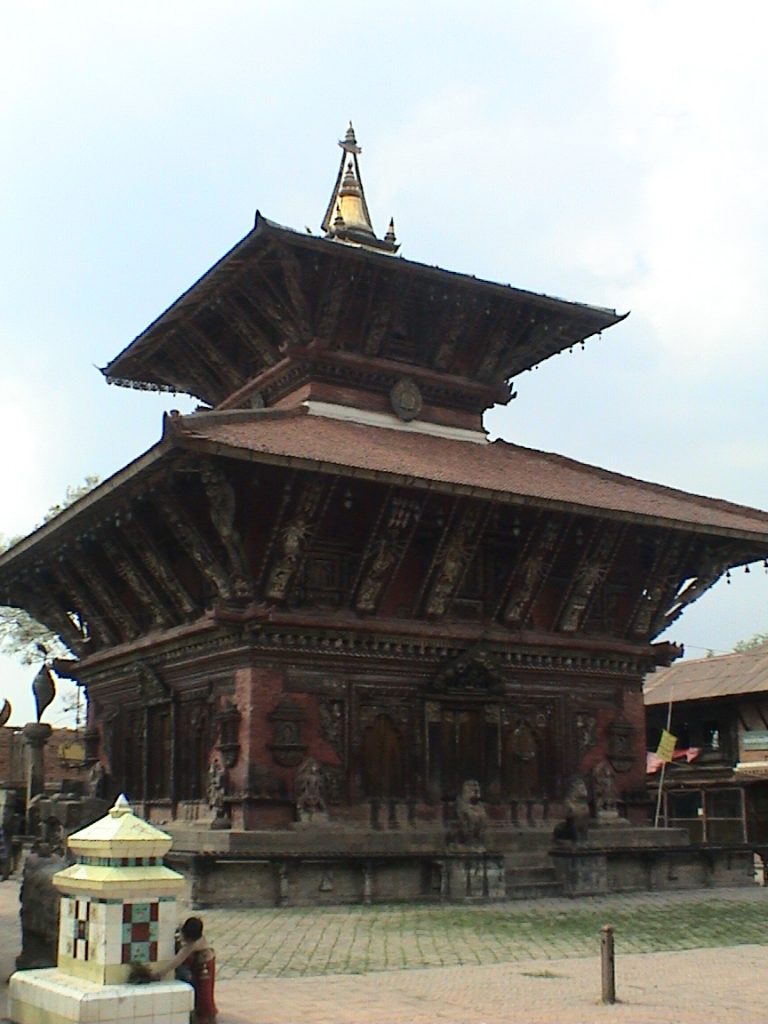
The Changu Narayan temple is a two story structure with copper and wood carvings all around it. The layout of the temple has been changed several times due to natural disasters damaging the temple. The four entrances to the temple all feature triple doorways that have been cut into the brick walls of the temple, and on the western entrance there are copper plated sheets molded over the carvings. The temple contains artworks from the fourth, ninth and thirteenth centuries, most of which are Newar art: work from the Newar people, an Indiginous Indo-Aryan group primarily from the Kathmandu Valley (Lo Bue et al., 1). Newa art is centered around Hindu and Buddhist deities, sculptures made in this art style use the lost-wax casting method (Lo Bue et al., 1). The most valued art piece is an earthquake damaged sculpture of Visnu in his universal form – Vishvarupa. Two other structures just outside of the temple are devoted to Laksmi. The centre of the temple has a mandapa, a hallway supported by pillars and a roof, that is used for public rituals. The mandapa was contributed to the temple by Jayprakash Malla, the final king of the Malla dynasty that ruled over the Kathmandu valley from 1200 – 1770 CE. Archaeologists suggest that the mandapa was the origin of the temple and that the brick walls that surround the temple were built afterwards (Sharma, 9).
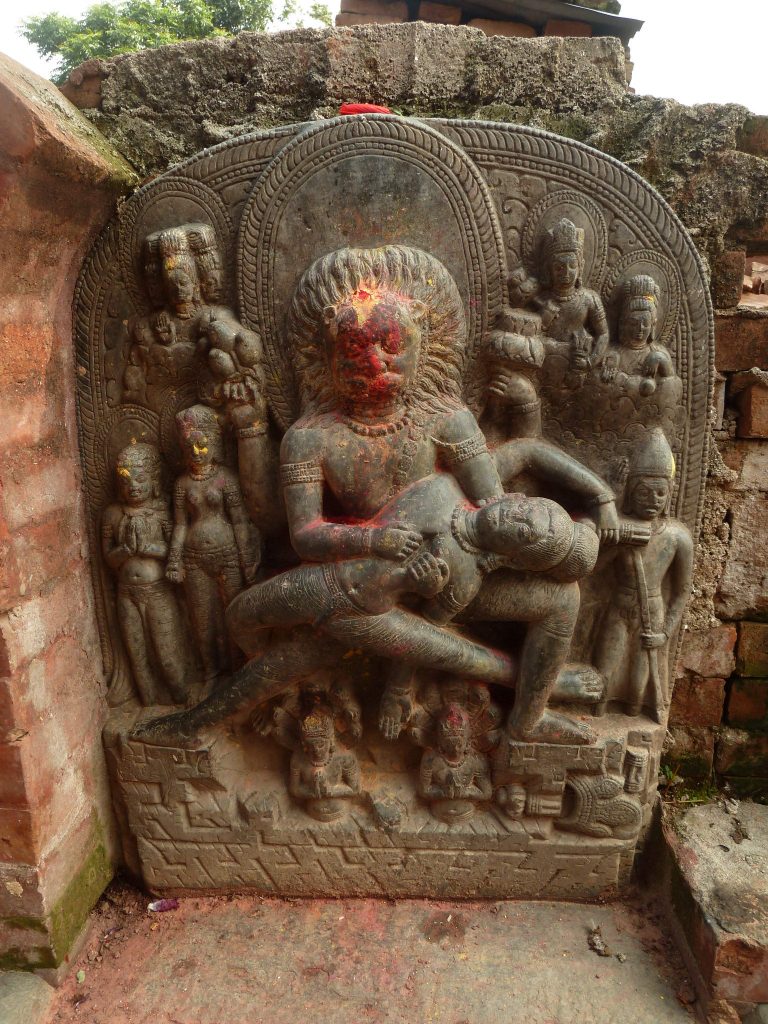
A stone pillar stands outside of the entrance to the temple with Sanskrit writings on it referencing king Manadeva and his mother queen Rajyavati of the Licchavi dynasty (Riccardi, 611). The pillar once stood directly directly in front of the shrine, but was knocked over and damaged sometime in the eighteenth century; as a result, the pillar now sits to the side of the entrance to the temple. Part of the inscription from the pillar was buried in the ground until 1899 when permission was given to dig up the lost section of the inscription and the pillar was fully read for the first time in recent years. The inscription is carved into three sides of the pillar with the first portion that was damaged when the pillar fell now on the northward facing side. The other two sides are in almost perfect condition. The first side of the pillar describes Sankaradeva, the son of the king Bhupalendra, who was renowned for his “perfect actions” and “upholding of Dharma” (Riccardi, 617). Sankaradeva gained permission from his father to expand the kingdom and through his actions became “as pure as moonlight in mind and body” (Riccardi, 617). The second side explains how Sankaradeva’s father dies and ascends to “the third heaven” (Riccardi, 617). Rajyavati the “true wife of the king” and Sankaradeva’s mother told him to rule in his father’s place after his passing (Riccardi, 618). The final side of the pillar explains Sankaradeva’s role as king Bhupalendra’s successor. Sankaradeva knew his devotion alone was not enough to repay his father. The boy was known for his wisdom as well as physical abilities and vowed to travel east to destroy his kingdom’s enemies. When Sankaradeva returned from the east having conquered several kings he was “pleased in spirit” and his devout mother Rajyavati should share her “happy heart” with her people (Riccardi, 618).
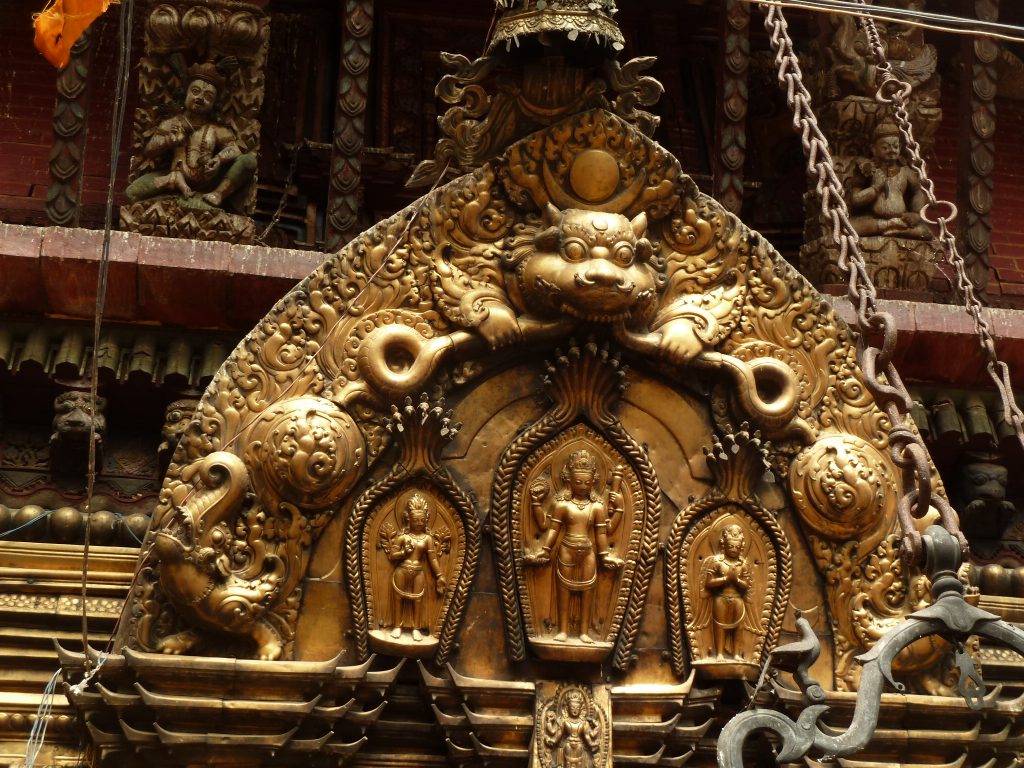
The Changu Narayan temple has been plagued with destruction since its creation and has been rebuilt on multiple occasions. The most recent of which was a 7.8 magnitude earthquake that affected most of Nepal and killed over nine thousand Nepalese people in April of 2015 (Mendoza, 11). A few of the main support pillars were compromised during the earthquake and a large granite slab fell from the second story laying next to a brass bell tangled in prayer flags. As the temple is upwards of thirteen hundred years old the structural integrity of the temple is not what it once was, combined with illegal mining operations at the base of the hill (Burke, 1). A British architect named John Sanday led an effort to restore the temple, but was appalled to see the state of the temple after the disaster (Mendoza, 11). Pillars and walls of the temple had been destroyed leaving large piles of rubble and debris strewn across the courtyard. The people living in the Changu village were distraught from the earthquake but offered what little they could to contribute to seeing the temple rebuilt to its former glory (Mendoza, 11).
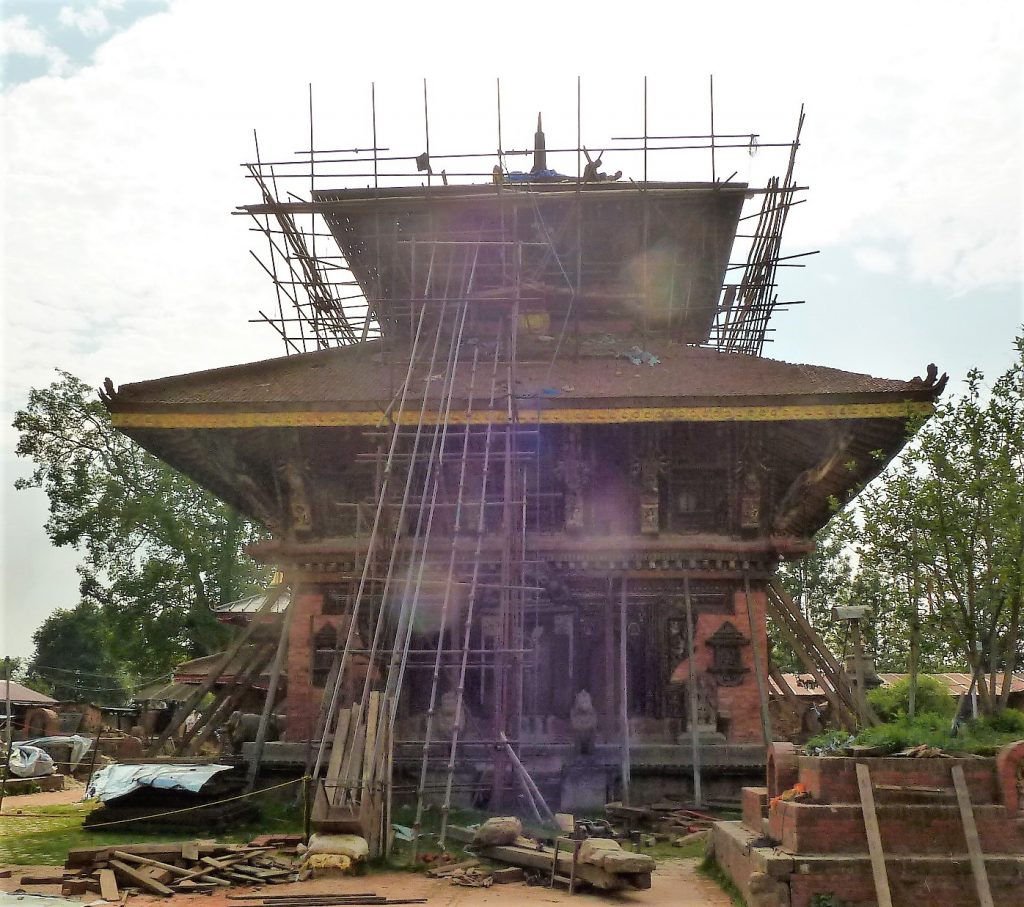
The country of Nepal relies on tourism, making up approximately 10% of the country’s total GDP, so with their famous landmarks being so greatly affected it impacts their culture and the country as a whole. Many of the people around the Kathmandu area have taken issue with the government’s treatment of the sacred site and blame the destruction on corrupt officials (Burke, 1). Global efforts have been started to reconstruct the temple; for example, Germany has contributed thirty thousand dollars of the needed three hundred thousand to start repairs on the heritage site (Mendoza, 11). In Nepal many aspects of ways of life are interconnected from religious to historical to economic elements. The residents around the temple have come together under a common goal of fixing the temple, not only for personal use, but for the benefit of Nepal as a whole.

References
Burke Jason (2015) “Nepal begins to assess its cultural losses after earthquake; Many
internationally recognised monuments preserved intact for centuries have been destroyed, but hope remains that Nepal’s shattered heritage sites can be rebuilt”. The Guardian 1:1 https://advance-lexis-com.ezproxy.uleth.ca/api/document?collection=news&id=urn:contentItem:5FWH-FCM1-JCJY-G3JX-00000-00&context=1516831.
Kaur Harsimran. (2017). “Changu Narayan: Ancient Hindu Temple in Nepal’s History:
Historical Significance.” 1:1 Accessed February 18, 2020 https://www.newsgram.com/ancient-hindu-temple-changu-narayan-in-nepal
Krishna, Nanditha (2001) The Book of Vishnu. New York: Penguin
Lo Bue, Erberto F., Ian Alsop, Adalbert J. Gail, Eric Chazot, Theodore Riccardi jr, Mary
Shepherd Slusser, John Sanday, Gautam Vajracharya, T. P. B. Riley-Smith, Anne Vergati, Susi Dunsmore, Bronwen Bledsoe, Ken Teague, and Judith Chase (2003) “Nepal.” Grove Art Online. 1:2-38 Accessed 18 Feb. 2020. doi:10.1093/9781884446054
Mendoza Martha (2017) “Architect rebuilds ancient temple.”The Associated Press Telegraph
Herald 1:11.
Riccardi, T. (1989) “The Inscription of King Mānadeva at Changu Narayan.” Journal of the
American Oriental Society 109(4):611-620 Accessed February 19, 2020 doi:10.2307/604086
Sharma, Prayag Raj (1999) “A Fresh Look At The Origin And Forms Of Early Temples
In The Kathmandu Valley.” Nepalese Studies 26: 8-9. http://www.thlib.org/static/reprints/contributions/CNAS_26_01_01.pdf.
Related Topics For Further Investigation
Visnu
Vishvarupa
Gwala
Brahmin
Licchavi kingdom
Rg Veda
Newar People
Lost-wax Casting
Indo-Aryan / Indic people
Prayer Flags
Mandapa
Related Websites
Changu Narayan Wikipedia Page
https://en.wikipedia.org/wiki/Changu_Narayan_Temple
General Information on The Temple
https://www.atlasobscura.com/places/changu-narayan
Pictures Documenting Damage From the Earthquake
https://rubinmuseum.org/page/then-and-now-changu-narayan
The Inscription on The Pillar Dedicated to King Manadeva
https://www.jstor.org/stable/604086?seq=1#page_scan_tab_contents
This article was written by: Ross Visser (Spring 2020), who is entirely responsible for its content.
